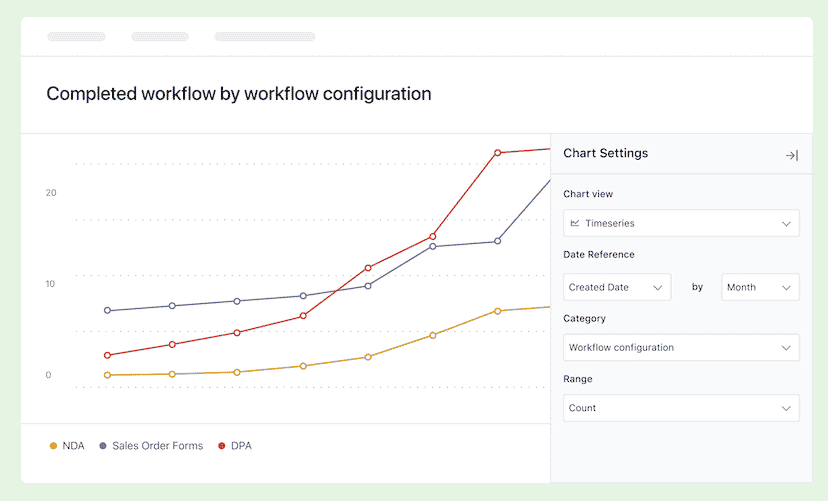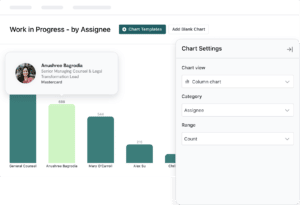Contracts contain hugely important information about your business – not just in the terms themselves, but also in how they are used within your company, when, and by whom.
In today’s data-driven business environment, your ability to quickly and accurately access this valuable contract data can be the difference between a good or bad decision, or between your legal team looking innovative or flat-footed. And when decisions or reporting are needed, there’s often no time for a special project to extract the needed data.
At Ironclad, our legal team employs a proactive data strategy as a cornerstone of the team’s operation and growth. Here’s a bit about how we do it.
Contract data at Ironclad Legal
At Ironclad, we focus on two major types of contract data.
First, there’s process data, which helps us keep a finger on the pulse of the business and how best to deploy our legal team resources. Second, there’s content metadata, which we use to quickly and accurately analyze our obligations to our customers.
We generate and verify this information through our use of Ironclad workflows, then harvest it through our Repository, our new Ironclad Insights feature, and other methods.
We report this data in several ways:
- The legal team packages certain key data points into weekly reports for our General Counsel and internal partners.
- We generate regular data visualizations using Insights that our General Counsel shares with the executive team.
- Quarterly, we produce a comprehensive internal contracting report, which gives us periodic opportunities to understand our commercial contracting system, celebrate progress, and identify areas for improvement.
- We also ensure that our metadata is as accurate as possible so that we can pull data quickly to respond to ad hoc business questions.
Process data keeps our finger on the company’s pulse
Our process data not only gives us a real-time look at what’s going on with the company, it also allows us to see trends so we can plan ahead and proactively anticipate the business’s needs.
1. Contracts generated and executed
Simply counting the number of a given type of contract may seem basic, but we find it can provide powerful information about what’s happening in our business. For example, here are a few of the things we count:
- Number of contracts by workflow type. This tells us which contracts are needed by business users and how often, helping us determine where to focus our energy on workflow streamlining and process improvement.
- Number of amendments. Tracking amendments helps us identify errors that may be happening upstream and common issues faced by counterparties, so we can strive to reduce amendments and the legal bandwidth they require.
- Number of customer agreements by market segment and by week of quarter. It can be difficult to capacity plan and divide responsibilities among a commercial team. With Ironclad, we can easily identify trends in when and how many agreements are generated by each sales team, helping us to make staffing and bandwidth decisions in real time and ahead of time.
2. Negotiation Rate
This is one of our favorite metrics to track.
After understanding how many contracts are being generated in your business, the next step is to reduce how much legal work is required for each contract. At Ironclad, sales agreements are our largest category of commercial work, and we closely track how many agreements require legal review and negotiation via options selected by users in each contract workflow.
Contracts that require no legal involvement at all are the gold standard. Because this metric is so important, we report on it weekly and do a deeper analysis by various categories in each quarterly report.
3. Turnaround Time
The Ironclad legal team maintains a Service Level Commitment (“SLC”) of contract turnaround times for our internal stakeholders. While publishing these standards to set expectations is great, going one step further and accurately tracking and reporting compliance with the SLC builds trust and rebuts any unwarranted criticism about slow review times.
We report weekly on SLC review times within our team and to key internal clients, which helps us ensure that we are meeting the needs of the business and proactively identifying any issues.
Contract metadata keeps us on top of our rights and obligations
After contracts are executed, they are stored in the Ironclad Repository with their associated metadata and links to all of the draft versions and negotiation history. With our contracts in an easily accessible and dynamic database, our team can deliver swift analysis and actionable insights, often without having to review a single page of the actual documents.
Here’s just a handful of examples of metadata that helps us help the business run more efficiently:
4. Publicity
At Ironclad, we track whether we have the right to publicly reference a customer, plus additional details such as logo rights and whether a customer has agreed to provide a case study or quote. Using the Ironcad platform, we even make this data easily accessible to business users through a dynamic link to our Repository, allowing for true self-service. Users can access this information without even needing to ask the legal team.
5. Security & Data Privacy
As a SaaS contract business, the security of our customer’s data is our top priority. That’s why we track a key set of metadata that allows us to stay on top of our privacy and security obligations to customers.
For example, if our company ever has to contend with a security breach, we would be able to quickly pull accurate information on which customers require what kind of notice, how quickly, and through what channel. Without Ironclad, gathering that type of information could require a lengthy contract review project in the high-pressure immediate aftermath of a breach.
We also track subprocessor notice obligations. If and when the business adds a new subprocessor, we can promptly notify the right set of customers, using the right channels and contacts.
6. Limitation of Liability
The legal nerds in us are excited to share this one. We track deviations from our standard limitation of liability term in customer agreements, and from there, whether the deviations are by a variable or fixed amount. This data not only helps us understand our risk as a company, it has also accelerated several initiatives.
In commercial negotiations, we’re able to benchmark and standardize liability exposure across our contracts. Operationally, our cross-functional partners have used this information in the corporate insurance renewal process. As the stewards entrusted with managing and mitigating our company’s risk, our legal team sleeps better at night knowing the data behind our potential contract liability.
We’re constantly evaluating
These are just a few examples of the contract metadata that we track. As a legal team, we’re constantly evaluating how our business is evolving and what contract insights would be most valuable to surface. Every business is unique, so determining what contract data to focus on will depend on your company’s unique priorities and operations. We believe Ironclad is the best tool to help you get there.
Interested in seeing how you can instantly track and report on these metrics for your team? Get in touch with our team today.
Ironclad is not a law firm, and this post does not constitute or contain legal advice. To evaluate the accuracy, sufficiency, or reliability of the ideas and guidance reflected here, or the applicability of these materials to your business, you should consult with a licensed attorney. Use of and access to any of the resources contained within Ironclad’s site do not create an attorney-client relationship between the user and Ironclad.
- Contract data at Ironclad Legal
- Process data keeps our finger on the company’s pulse
- Contract metadata keeps us on top of our rights and obligations
- We’re constantly evaluating
Want more content like this? Sign up for our monthly newsletter.





